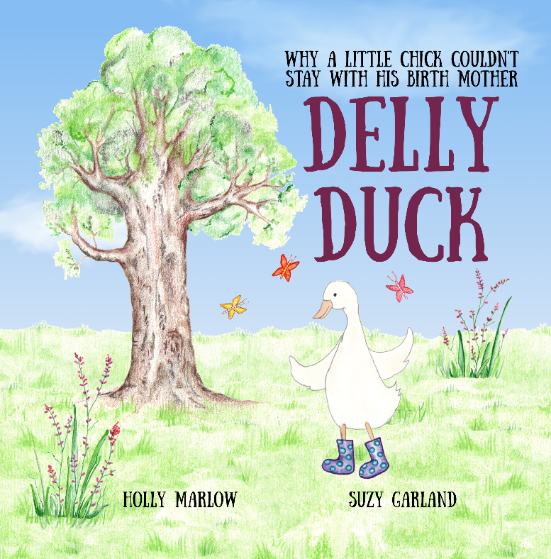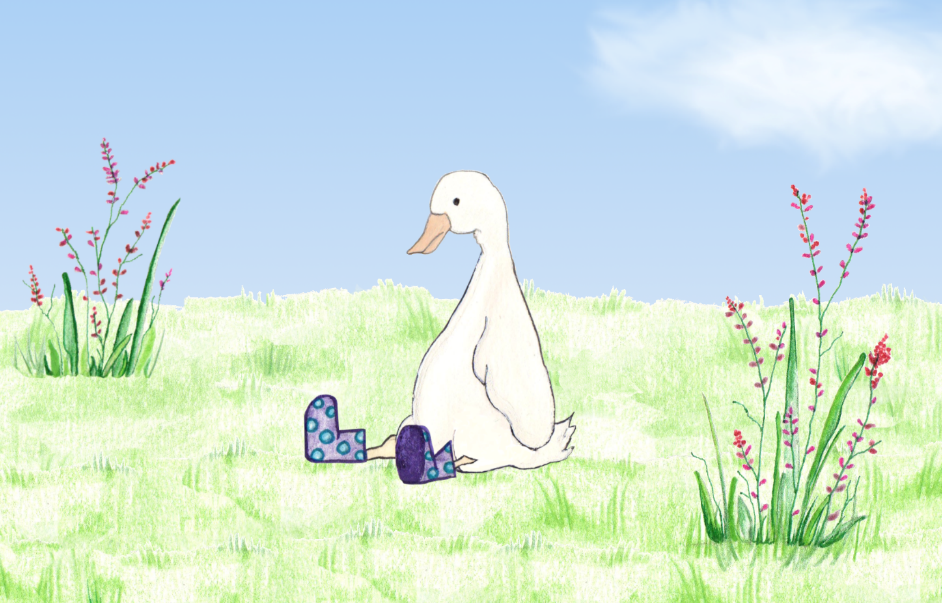“Delly Duck: Why A Little Chick Couldn’t Stay With His Birth Mother” is a beautifully illustrated children’s story book, explaining big issues like adoption and fostering, in an age appropriate way. The book is written by Holly Marlow and illustrated by Suzy Garland. In this interview, Holly shares what the book is about and how it can be used as a tool for therapeutic life story work.

Hello! I’m Holly Marlow, parent to both biological and adopted children and author of “Delly Duck: Why A Little Chick Couldn’t Stay With His Birth Mother”. The children’s book is about foster care and adoption, intended to support therapeutic life story work and more general discussions about adoption and fostering. I have a five year old birth daughter and two year old adopted son, who has been part of our family for just over a year.

Tell us about your book
I wrote “Delly Duck: Why A Little Chick Couldn’t Stay With His Birth Mother,” to help with some of the tricky and emotional questions that an adopted child (or another child trying to understand adoption) may have.
No two adoption stories are the same, so I included a lot of symbolism that the adult reading this story can interpret appropriately when reading it to a child. Delly Duck chasing butterflies may be interpreted as a metaphor for an addiction that existed pre-birth and that Delly sadly does not overcome. Alternatively, this frequent distraction may more simply represent memory and concentration problems that might arise from Delly’s own traumatic experiences, health issues or learning disability.
What age group is “Delly Duck: Why A Little Chick Couldn’t Stay with his Birth Mother” suitable for?
It’s quite a wide range really, because as the child gets older, they will be able to understand more from the metaphors. I recommend it from three years old but have had feedback that it has helped children with an emotional age of eight and nine years old to process their feelings and questions about adoption. I’ve also been contacted by a few adult adoptees who have adopted as well, and wanted to let me know that they bought it for their children, but also found it therapeutic for themselves.
The story made me root for Delly somehow, even though I could see that she wasn’t making the necessary changes to keep Little Chick. Was that your plan?
It was one of my main objectives actually! I wanted to ensure that the reader developed empathy for the birth parent character. I wanted them to see that Delly tried to make some changes (trying to build the nest, for example) and that the social worker tried to support her with advice and at times practical help, but sadly it was still not safe for Little Chick to stay with Delly.
I hope that the adoptive parents using this book to support therapeutic lifestory work, will use the opportunity to discuss the things that birth parents tried to do to keep their children. Hopefully this will ensure that children know that they are loved and wanted, as well as showing them that their adoptive parents do not villainise their birth parents and can be approached to discuss any feelings or questions the child may have about their birth family.
Similarly, I hope that parents use the story to relate to any help and advice that social services provided, so that they can explain that the decision to remove a child is not taken lightly and that birth parents do receive support.

I felt like Delly didn’t have any closure. She’s sad the last time we see her in the story. Why did you leave it like that?
Although it feels uncomfortable, I feel it would be disrespectful to the birth parents who have lost their children to adoption if I were to say that Delly was happy knowing that Little Chick was safe and loved. I imagine that Delly would be distraught and would worry about whether Little Chick was safe, healthy and happy in his new home, which she knows nothing about.
I did soften it a little in the story, where Delly agreed that Little Chick’s safety was the most important thing. This can be interpreted as Delly realising that, despite her attempts to provide a safe home, she will not be able to persuade Caring Goose that Little Chick will be consistently safe in her care. Most birth parents fight the process at least for a while, which is something the adult reading the story can discuss with the child.
I think it’s important to acknowledge that it’s sad. While I, as an adoptive mum, am so lucky to have such a fantastic child and I make sure he knows that I am so happy he is my son, I am acutely aware that his birth parents must miss him terribly. It’s important that he sees that empathy in me and knows he can ask me anything about them.
What inspired you to write a children’s book about adoption?
This book came to life while I was waiting for matching panel and having discussions with my birth daughter about adopting a younger sibling. My daughter asked me a lot of questions about all aspects of the process, but the thing she really struggled to get her head around was the separation of a child from his or her mother.
She rightly identified that this must be a difficult and distressing aspect of adoption, and couldn’t understand why a mother and child would or should ever be separated. I wanted to support her empathy towards the birth mother, while gently showing that the decision to remove a child from their mother would not have been taken lightly. Above all, I wanted to portray that all adults involved wanted the best for Little Chick, and that he is so very loved.
You can buy “Delly Duck: Why a Little Chick Couldn’t Stay With His Birth Mother” from Amazon. Holly’s website is a great resource for anyone wanting to know more about adoption. If you don’t follow her already on Instagram, go and say hello.
To read reviews and information about other adoption books, click here.
This interview includes an affiliate link for the book. That means if you click on the link in the article to Amazon, and then buy the book, I get paid a fee from Amazon.


